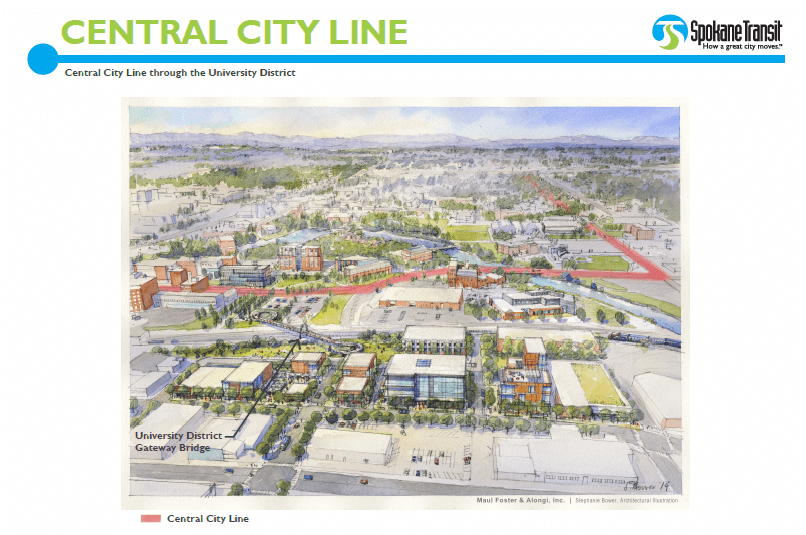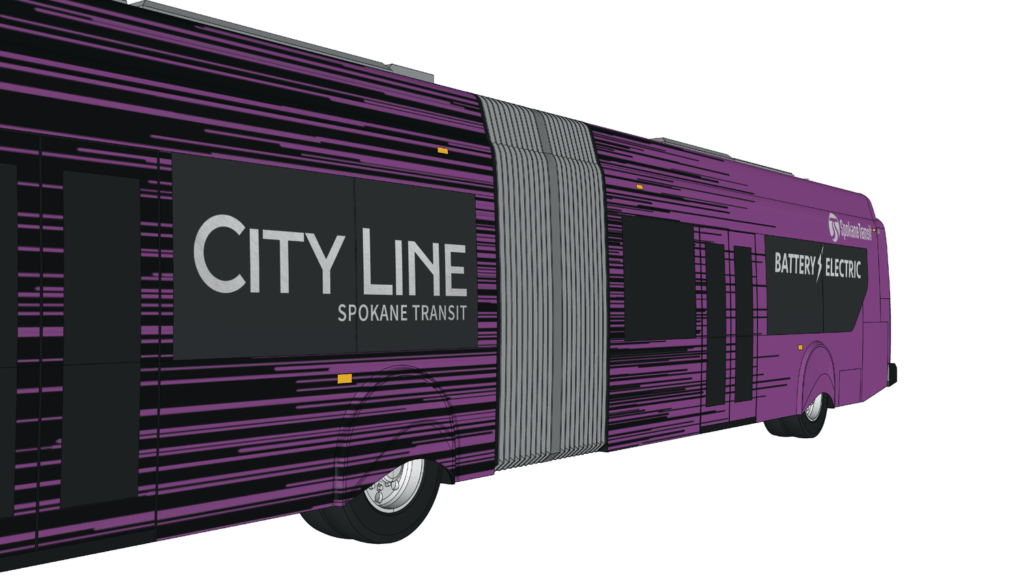
Rapid Transit Line Drives Toward Reality In Eastern Washington With Grant For Spokane Buses
LISTEN
A type of transit that some Puget Sound-region commuters know well is heading east.
The first bus rapid transit system in Washington east of the Cascades moved further down the line this week, as the Spokane Transit Authority bought 10, 60-foot fully electric buses to service the route.
After the buses are delivered next year, they’ll run the Spokane City Line, a six-mile loop through downtown connecting Spokane Community College with the Browne’s Addition neighborhood. The line is expected to begin operation in 2022.
Candace Mumm, the immediate past president of STA’s board of directors and a Spokane City Council member, said the timing of the project couldn’t be better, especially with the coronavirus outbreak.
“This is essential to the rebirth of our city coming out of the COVID crisis,” Mumm said. “I think the timing is perfect because transit is essential. We can get to work on this right away. It will help provide jobs for the community. It will improve our downtown core and provide the backbone and support for coming out of this crisis.”
BRT basics
Bus rapid transit is something like a hybrid between a bus and commuter train. The vehicles run on rubber tires, but passengers purchase fares at kiosks before boarding, and can enter through any of the four doors on the long, articulated buses. They also run frequently. In Spokane’s case, every seven and a half minutes during rush hour.
BRT lines typically have dedicated lanes for the buses where no other vehicles are allowed, but Spokane’s system will not.
The New Flyer Industries Xcelsior Charge buses each cost $1,261,683.46. The total price of $13.9 million was paid by a federal grant, and includes a 10% contingency budget for unforeseen future costs as well as for the purchase of spare components from New Flyer.
Spokane’s transit agency had $18.2 million in grant money to purchase the buses. The STA board of directors approved the purchase April 16.
The move comes at a time when ridership in Spokane plummeted by 70% in March due to the coronavirus pandemic reducing demand for transit. The agency stopped its express lines in response.
State and federal funding for the transit line has already been allocated and won’t be impacted by the expected budget disarray caused by coronavirus fallout.
Initiative 976, the $30 vehicle registration fee measure that voters approved in November, won’t affect the work either. The measure has been put on hold while it makes it way through the legal system. The Washington Supreme Court is expected to hear a request for an emergency injunction against the measure later this month.
Paying for it
Spokane City Councilman Michael Cathcart is not on STA’s board of directors, but he represents the city’s District 1, where a section of the City Line will run.
He’s also the only self-identified conservative on the council, but he still supports the $92 million project.
“It’s so far along,” Cathcart said. “I think the money’s long been allocated and voter approved. I think it would behoove STA to take a step back and analyze things from a financial perspective so they’re not over extended.”
Though 20 years in the making, the system got voter support in November 2016, when 56% of Spokane voters approved a local sales tax increase to fund the agency’s 10-year plan, which included the City Line.

Spokane will soon have 10 electric New Flyer Industries Xcelsior Charge buses for its rapid transit system, paid for by a federal transportation grant. CREDIT: Spokane Transit Authority
The project was only finalized in April 2019, when STA won a Federal Transit Administration Small Starts grant of $53.4 million. The grant is part of a larger program that allocates about $2.3 billion in funding every year for all kinds of transit projects including commuter rail and streetcars.
Beside that grant money, the project received $15 million in 2015 Connecting Washington transportation funding from the state, $2.2 million in state regional mobility grant funding, and $1.4 million from a federal Congestion Mitigation and Air Quality grant, which the state administers.
STA pulled $20 million from its reserves to help pay for the project.
Cathcart says the project isn’t perfect, and pointed to the case of Maricruz Monrreal. One of the line’s stations will take part of the front yard in in Spokane’s Chief Garry neighborhood.
“It feels like they just tossed a dirty diaper and it landed on my property,” Monrreal told KXLY in 2019.
STA says all City Line construction will occur in the public right-of-way.
Boom along the line
Cathcart will be watching how the line changes his district.
“I will be interested to see what happens with density along the line,” he said. “It’s going to take some trends in the market for it to make sense to people to buy up some of the older stock and build it up. But it’s going to be a great place for housing.”
An economic analysis of the project done in 2014 estimated that property along the route would gain $45 million in value over the next 30 years, and generate $175 million in property improvements.
“It will be a boon to downtown businesses,” said Mumm. “What we know is when a transit line like this is activated, it becomes very reliable for companies to locate, or they can offer this option for their workers so they don’t have to buy downtown parking passes.”
A more common transit
Bus rapid transit systems are becoming more common, as a relatively inexpensive way for cities to build modern transit systems. According to BRTData and the Institute for Transportation & Development Policy, there are 172 cities worldwide with such systems, 19 of them in U.S.
Three cities in the Northwest have BRT, including Seattle’s RapidRide, Everett’s Swift, and the Emerald Express, or EmX system, in Eugene, Oregon. Portland is also developing a BRT line.
Most other lines in the U.S. are located in Southern California and the northeastern U.S., but there are BRT systems in Fort Collins, Colorado, as well as in Miami and Orlando, Florida.
BRT lines are a common sight in Latin America, where 55 city systems carry almost 21 million passengers a day. This type of bus-priority transit was first practiced in Curitiba, Brazil, where it was launched in 1974.
The systems aren’t always successful. A 3.6-mile BRT line in Delhi, India, opened in 2008 with projections of giving 12,000 rides an hour. Instead, traffic congestion increased and the system’s technology malfunctioned. In 2016, the line was scrapped and the city government spent $1.6 million tearing out the infrastructure.
The largest BRT system in the world is in Jakarta, Indonesia. Implemented in 2004, the 250-kilometer system operates 3,900 buses and in February 2020 reached a goal of giving rides to 1 million people in one day.
When Spokane’s line begins, STA anticipates it will give 1 million rides a year.
Construction on the first City Line stations will begin in May.
Related Stories:

Washington ferry service to be restored to pre-pandemic levels by summer, governor says
The diesel-powered state ferry Tacoma, shown here in Seattle, will not be pulled from service anytime soon for conversion to hybrid-electric propulsion by order of Gov. Bob Ferguson. (Credit: Tom

How Washington’s small airports are getting their flights back
The Walla Walla Regional Airport once again has two daily roundtrip flights that connect it to Seattle. (Credit: Susan Shain / NWPB) Listen (Runtime :59) Read During the pandemic, Alaska

Feds update Columbia River Treaty flood risk management
Grand Coulee Dam in eastern Washington. Changes to the Columbia River Treaty could mean more flood risk management is controlled at the dam. (Credit: Shutterbug Fotos / Flickr Creative Commons)















